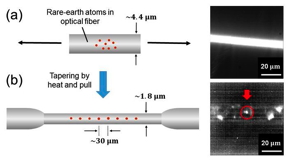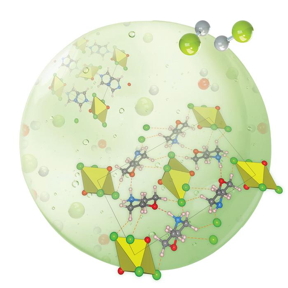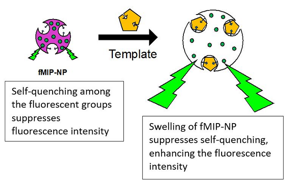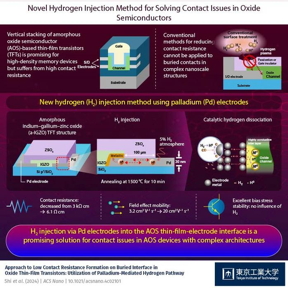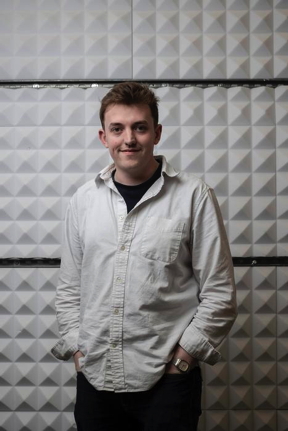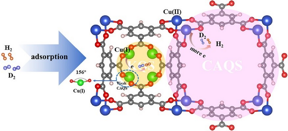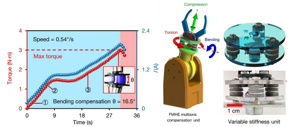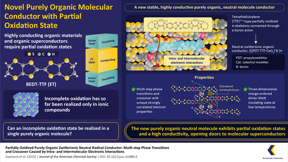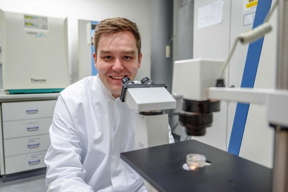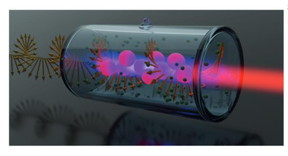Home > Press > NRL discovers two-dimensional waveguides
 |
| Confocal microscope image of waveguided photoluminescence in a hexagonal boron nitride waveguide. The lobe-pattern around the edges is reminiscent of koi circling a pond. Image taken by Samuel LaGasse in April 2023. CREDIT U.S. Naval Research Laboratory/Samuel LaGasse |
Abstract:
The U.S. Naval Research Laboratory (NRL), in collaboration with Kansas State University, announce the discovery of slab waveguides based on the two-dimensional material hexagonal boron nitride. This milestone has been reported in the journal Advanced Materials.
NRL discovers two-dimensional waveguides
Washington, DC | Posted on February 16th, 2024
Two-dimensional (2D) materials are a class of materials which can be reduced to the monolayer limit by mechanically peeling the layers apart. The weak interlayer attractions, or van der Waals attraction, allows the layers to be separated via the so-called “Scotch tape” method. The most famous 2D material, graphene, is a semimetallic material consisting of a single layer of carbon atoms. Recently, other 2D materials including semiconducting transition metal dichalcogenides (TMDs) and insulating hexagonal boron nitride (hBN) have also garnered attention. When reduced near the monolayer limit, 2D materials have unique nanoscale properties which are appealing for creating atomically thin electronic and optical devices.
“We knew using hexagonal boron nitride would lead to outstanding optical properties in our samples, none of us expected that it would also act a waveguide,” said Samuel Lagasse, Ph.D., Novel Materials and Applications Division. “Since hBN is used so widely in 2D material–based devices, this novel usage as an optical waveguide potentially has wide-ranging impacts.“
Graphene and TMD monolayers are both extremely sensitive to the surrounding environment. Therefore, researchers have sought to protect these materials by encapsulating them in a passivating layer. This is where hBN comes in: layers of hBN are able to “screen” impurities near graphene or TMD layers, leading to fantastic properties. In recent NRL-led work, the thickness of hBN surrounding a light-emitting TMD layer was carefully tuned in order to support optical waveguide modes.
Researchers at NRL carefully assembled stacks of 2D materials, known as “van der Waals heterostructures.” These heterostructures can have specialized properties due to the layering. Slabs of hBN were placed around single layers of TMDs, such as molybdenum diselenide or tungsten diselenide, which can emit light in the visible and near-infrared. The slabs of hBN were carefully tuned in thickness so that the emitted light would be trapped within the hBN and waveguided. When the light waveguides to the edge of the hBN, it can scatter out and be detected by a microscope.
The research was motivated by the challenges of optical measurements of 2D TMDs. When laser light is focused on TMDs, particles known as excitons are generated. Most excitons emit light out of the plane of the TMD, however an elusive type of exciton known as a “dark” exciton exists in some TMDs, emits in the plane of the TMD. NRL’s slab waveguides capture the light from the dark excitons, providing a way to study them optically.
“2D materials have exotic optoelectronic properties that will be useful to the Navy,” said Lagasse. “A large challenge is interfacing these materials with existing platforms without damaging them – these boron nitride waveguides are a step towards that realization.”
NRL researchers used two special types of optical microscopes to characterize the hBN waveguides. One setup allows researchers to spectroscopically resolve photoluminescence emitting from different spots of the waveguide. The other setup let them observe the angular distribution of the emitted light.
NRL researchers also developed 3D electromagnetic models of the waveguides. The modeling results provide a toolkit for designing future 2D devices that use slab waveguides.
####
About U.S. Naval Research Laboratory
L is a scientific and engineering command dedicated to research that drives innovative advances for the U.S. Navy and Marine Corps from the seafloor to space and in the information domain. NRL is located in Washington, D.C. with major field sites in Stennis Space Center, Mississippi; Key West, Florida; Monterey, California, and employs approximately 3,000 civilian scientists, engineers and support personnel.
For more information, contact NRL Corporate Communications at (202) 480-3746 or .
For more information, please click here
Contacts:
Mary Hamisevicz
U.S. Naval Research Laboratory
Cell: (202) 480-3746
@USNRL
Copyright © U.S. Naval Research Laboratory
If you have a comment, please Contact us.
Issuers of news releases, not 7th Wave, Inc. or Nanotechnology Now, are solely responsible for the accuracy of the content.
| Related Links |
| Related News Press |
2 Dimensional Materials
News and information
![]() Detecting breast cancer through a spit test February 16th, 2024
Detecting breast cancer through a spit test February 16th, 2024
![]() New chip opens door to AI computing at light speed February 16th, 2024
New chip opens door to AI computing at light speed February 16th, 2024
![]() HKUST researchers develop new integration technique for efficient coupling of III-V and silicon February 16th, 2024
HKUST researchers develop new integration technique for efficient coupling of III-V and silicon February 16th, 2024
![]() Under pressure – space exploration in our time: Advancing space exploration through diverse collaborations and ethical policies February 16th, 2024
Under pressure – space exploration in our time: Advancing space exploration through diverse collaborations and ethical policies February 16th, 2024
Graphene/ Graphite
Laboratories
![]() A battery’s hopping ions remember where they’ve been: Seen in atomic detail, the seemingly smooth flow of ions through a battery’s electrolyte is surprisingly complicated February 16th, 2024
A battery’s hopping ions remember where they’ve been: Seen in atomic detail, the seemingly smooth flow of ions through a battery’s electrolyte is surprisingly complicated February 16th, 2024
Govt.-Legislation/Regulation/Funding/Policy
![]() New chip opens door to AI computing at light speed February 16th, 2024
New chip opens door to AI computing at light speed February 16th, 2024
![]() A battery’s hopping ions remember where they’ve been: Seen in atomic detail, the seemingly smooth flow of ions through a battery’s electrolyte is surprisingly complicated February 16th, 2024
A battery’s hopping ions remember where they’ve been: Seen in atomic detail, the seemingly smooth flow of ions through a battery’s electrolyte is surprisingly complicated February 16th, 2024
Possible Futures
![]() Detecting breast cancer through a spit test February 16th, 2024
Detecting breast cancer through a spit test February 16th, 2024
![]() A battery’s hopping ions remember where they’ve been: Seen in atomic detail, the seemingly smooth flow of ions through a battery’s electrolyte is surprisingly complicated February 16th, 2024
A battery’s hopping ions remember where they’ve been: Seen in atomic detail, the seemingly smooth flow of ions through a battery’s electrolyte is surprisingly complicated February 16th, 2024
![]() Under pressure – space exploration in our time: Advancing space exploration through diverse collaborations and ethical policies February 16th, 2024
Under pressure – space exploration in our time: Advancing space exploration through diverse collaborations and ethical policies February 16th, 2024
Chip Technology
![]() New chip opens door to AI computing at light speed February 16th, 2024
New chip opens door to AI computing at light speed February 16th, 2024
![]() HKUST researchers develop new integration technique for efficient coupling of III-V and silicon February 16th, 2024
HKUST researchers develop new integration technique for efficient coupling of III-V and silicon February 16th, 2024
![]() ‘Sudden death’ of quantum fluctuations defies current theories of superconductivity: Study challenges the conventional wisdom of superconducting quantum transitions January 12th, 2024
‘Sudden death’ of quantum fluctuations defies current theories of superconductivity: Study challenges the conventional wisdom of superconducting quantum transitions January 12th, 2024
Optical computing/Photonic computing
![]() New chip opens door to AI computing at light speed February 16th, 2024
New chip opens door to AI computing at light speed February 16th, 2024
![]() HKUST researchers develop new integration technique for efficient coupling of III-V and silicon February 16th, 2024
HKUST researchers develop new integration technique for efficient coupling of III-V and silicon February 16th, 2024
![]() Thermal impact of 3D stacking photonic and electronic chips: Researchers investigate how the thermal penalty of 3D integration can be minimized December 8th, 2023
Thermal impact of 3D stacking photonic and electronic chips: Researchers investigate how the thermal penalty of 3D integration can be minimized December 8th, 2023
![]() Successful morphing of inorganic perovskites without damaging their functional properties October 6th, 2023
Successful morphing of inorganic perovskites without damaging their functional properties October 6th, 2023
Discoveries
![]() HKUST researchers develop new integration technique for efficient coupling of III-V and silicon February 16th, 2024
HKUST researchers develop new integration technique for efficient coupling of III-V and silicon February 16th, 2024
![]() Superbug killer: New synthetic molecule highly effective against drug-resistant bacteria February 16th, 2024
Superbug killer: New synthetic molecule highly effective against drug-resistant bacteria February 16th, 2024
Announcements
![]() Detecting breast cancer through a spit test February 16th, 2024
Detecting breast cancer through a spit test February 16th, 2024
![]() New chip opens door to AI computing at light speed February 16th, 2024
New chip opens door to AI computing at light speed February 16th, 2024
![]() HKUST researchers develop new integration technique for efficient coupling of III-V and silicon February 16th, 2024
HKUST researchers develop new integration technique for efficient coupling of III-V and silicon February 16th, 2024
Interviews/Book Reviews/Essays/Reports/Podcasts/Journals/White papers/Posters
![]() Detecting breast cancer through a spit test February 16th, 2024
Detecting breast cancer through a spit test February 16th, 2024
![]() New chip opens door to AI computing at light speed February 16th, 2024
New chip opens door to AI computing at light speed February 16th, 2024
![]() HKUST researchers develop new integration technique for efficient coupling of III-V and silicon February 16th, 2024
HKUST researchers develop new integration technique for efficient coupling of III-V and silicon February 16th, 2024
Military
![]() New chip opens door to AI computing at light speed February 16th, 2024
New chip opens door to AI computing at light speed February 16th, 2024
![]() ‘Sudden death’ of quantum fluctuations defies current theories of superconductivity: Study challenges the conventional wisdom of superconducting quantum transitions January 12th, 2024
‘Sudden death’ of quantum fluctuations defies current theories of superconductivity: Study challenges the conventional wisdom of superconducting quantum transitions January 12th, 2024
![]() World’s first logical quantum processor: Key step toward reliable quantum computing December 8th, 2023
World’s first logical quantum processor: Key step toward reliable quantum computing December 8th, 2023
![]() Inverted perovskite solar cell breaks 25% efficiency record: Researchers improve cell efficiency using a combination of molecules to address different November 17th, 2023
Inverted perovskite solar cell breaks 25% efficiency record: Researchers improve cell efficiency using a combination of molecules to address different November 17th, 2023
Photonics/Optics/Lasers
![]() New chip opens door to AI computing at light speed February 16th, 2024
New chip opens door to AI computing at light speed February 16th, 2024
![]() HKUST researchers develop new integration technique for efficient coupling of III-V and silicon February 16th, 2024
HKUST researchers develop new integration technique for efficient coupling of III-V and silicon February 16th, 2024
![]() A battery’s hopping ions remember where they’ve been: Seen in atomic detail, the seemingly smooth flow of ions through a battery’s electrolyte is surprisingly complicated February 16th, 2024
A battery’s hopping ions remember where they’ve been: Seen in atomic detail, the seemingly smooth flow of ions through a battery’s electrolyte is surprisingly complicated February 16th, 2024
![]() Development of zinc oxide nanopagoda array photoelectrode: photoelectrochemical water-splitting hydrogen production January 12th, 2024
Development of zinc oxide nanopagoda array photoelectrode: photoelectrochemical water-splitting hydrogen production January 12th, 2024
- SEO Powered Content & PR Distribution. Get Amplified Today.
- PlatoData.Network Vertical Generative Ai. Empower Yourself. Access Here.
- PlatoAiStream. Web3 Intelligence. Knowledge Amplified. Access Here.
- PlatoESG. Carbon, CleanTech, Energy, Environment, Solar, Waste Management. Access Here.
- PlatoHealth. Biotech and Clinical Trials Intelligence. Access Here.
- Source: http://www.nanotech-now.com/news.cgi?story_id=57447
- :has
- :is
- :not
- :where
- 000
- 10
- 12th
- 16th
- 17th
- 202
- 2023
- 27
- 2D
- 2D materials
- 3d
- 4
- 6th
- 7th
- 8th
- a
- Able
- accuracy
- Act
- acute
- address
- advanced
- Advanced materials
- advances
- advancing
- against
- AI
- allows
- also
- an
- and
- Angular
- Announce
- apart
- appealing
- applications
- approximately
- April
- ARE
- around
- Array
- AS
- assembled
- At
- attention
- attraction
- attractions
- awarded
- based
- batteries
- BE
- been
- both
- breaks
- Breast cancer
- by
- california
- CAN
- Cancer
- capture
- carbon
- carefully
- cell
- Center
- CGI
- challenge
- challenges
- characterize
- chip
- Chips
- civilian
- class
- click
- collaboration
- collaborations
- COM
- combination
- comes
- comment
- commitment
- Communications
- compatible
- computing
- conductor
- conducts
- Consisting
- contact
- content
- conventional
- Corporate
- corps
- could
- Creating
- credit
- Current
- D.C.
- damaging
- Dark
- dc
- Death
- December
- dedicated
- del
- designing
- detail
- detected
- develop
- developed
- Devices
- different
- direction
- discovered
- Discovers
- discovery
- distribution
- diverse
- Division
- domain
- Door
- drives
- due
- Edge
- edges
- Effective
- efficiency
- efficient
- electrolyte
- Electronic
- employs
- end
- energy
- Engineering
- Engineers
- Environment
- Ether (ETH)
- ethical
- existing
- exists
- Exotic
- expected
- exploration
- extremely
- famous
- fantastic
- far
- February
- field
- First
- florida
- flow
- fluctuations
- focused
- For
- Foundation
- from
- functional
- further
- future
- garnered
- generated
- gif
- Global
- Graphene
- Harvesting
- Have
- Health
- highly
- How
- However
- http
- HTTPS
- huge
- human
- hydrogen
- if
- image
- Impact
- Impacts
- improve
- in
- Inc.
- Including
- information
- innovative
- inorganic
- integration
- investigate
- IT
- January
- journal
- jpg
- Kansas
- Key
- killer
- knew
- known
- laboratory
- large
- laser
- layer
- layering
- layers
- lead
- leading
- less
- let
- li
- light
- LIMIT
- links
- lithium
- located
- logical
- major
- Marine
- material
- materials
- measurements
- metal
- method
- Microscope
- milestone
- Mississippi
- modeling
- models
- modes
- molecule
- more
- most
- motivated
- multiple
- nanotechnology
- Near
- net
- New
- news
- None
- novel
- November
- now
- observe
- october
- of
- on
- ONE
- opens
- optical
- Optimize
- or
- order
- organic
- Other
- our
- out
- outstanding
- Paul
- Personnel
- PHP
- physicist
- placed
- plane
- Platforms
- plato
- Plato Data Intelligence
- PlatoData
- please
- POND
- Post
- posted
- potential
- potentially
- power
- press
- Press Release
- pressure
- Processor
- produce
- properties
- protect
- provide
- providing
- Quantum
- rapidly
- realization
- recent
- recently
- record
- Reduced
- release
- Releases
- reliable
- remember
- reminiscent
- Reported
- research
- researchers
- resolve
- responsible
- Results
- return
- revolutionary
- Risk
- s
- safely
- Said
- Save
- scientific
- scientists
- Screen
- Search
- seemingly
- seen
- Semiconductors
- sensitive
- setup
- Share
- Shows
- significantly
- single
- Sites
- SIX
- smooth
- So
- solar
- solely
- solid
- some
- sought
- Space
- space exploration
- special
- specialized
- spots
- stacking
- Stacks
- start
- State
- Step
- Study
- submit
- such
- sudden
- Superconductivity
- support
- surprisingly
- Surrounding
- sustainable
- synthetic
- Systems
- tackle
- taken
- technique
- than
- that
- The
- the information
- their
- Them
- therefore
- thermal
- These
- thin
- this
- Through
- time
- to
- toolkit
- toward
- towards
- transition
- trapped
- trial
- tuned
- two
- type
- types
- u.s.
- U.S. Navy
- unique
- university
- unlocks
- us
- Usage
- use
- used
- useful
- using
- via
- visible
- was
- washington
- Waste
- Water
- Wave
- Way..
- were
- West
- when
- which
- widely
- will
- wisdom
- with
- within
- without
- Work
- would
- Yahoo
- you
- zephyrnet











